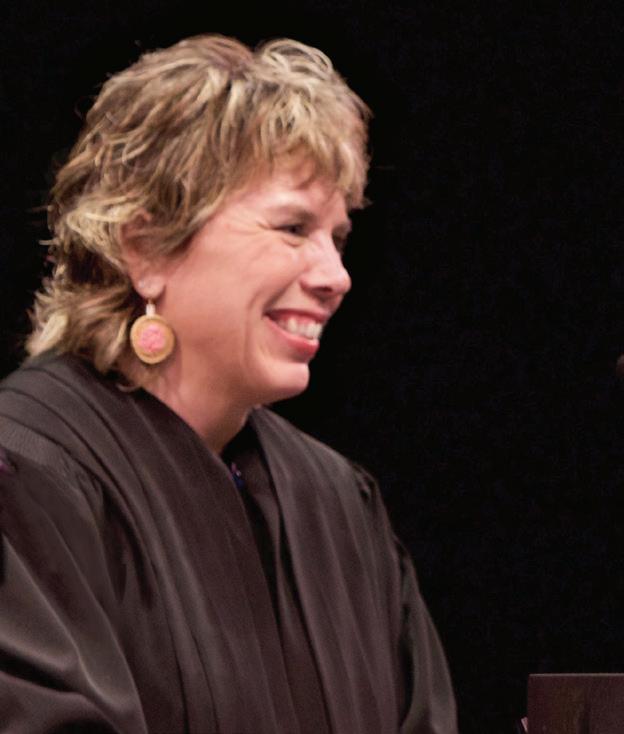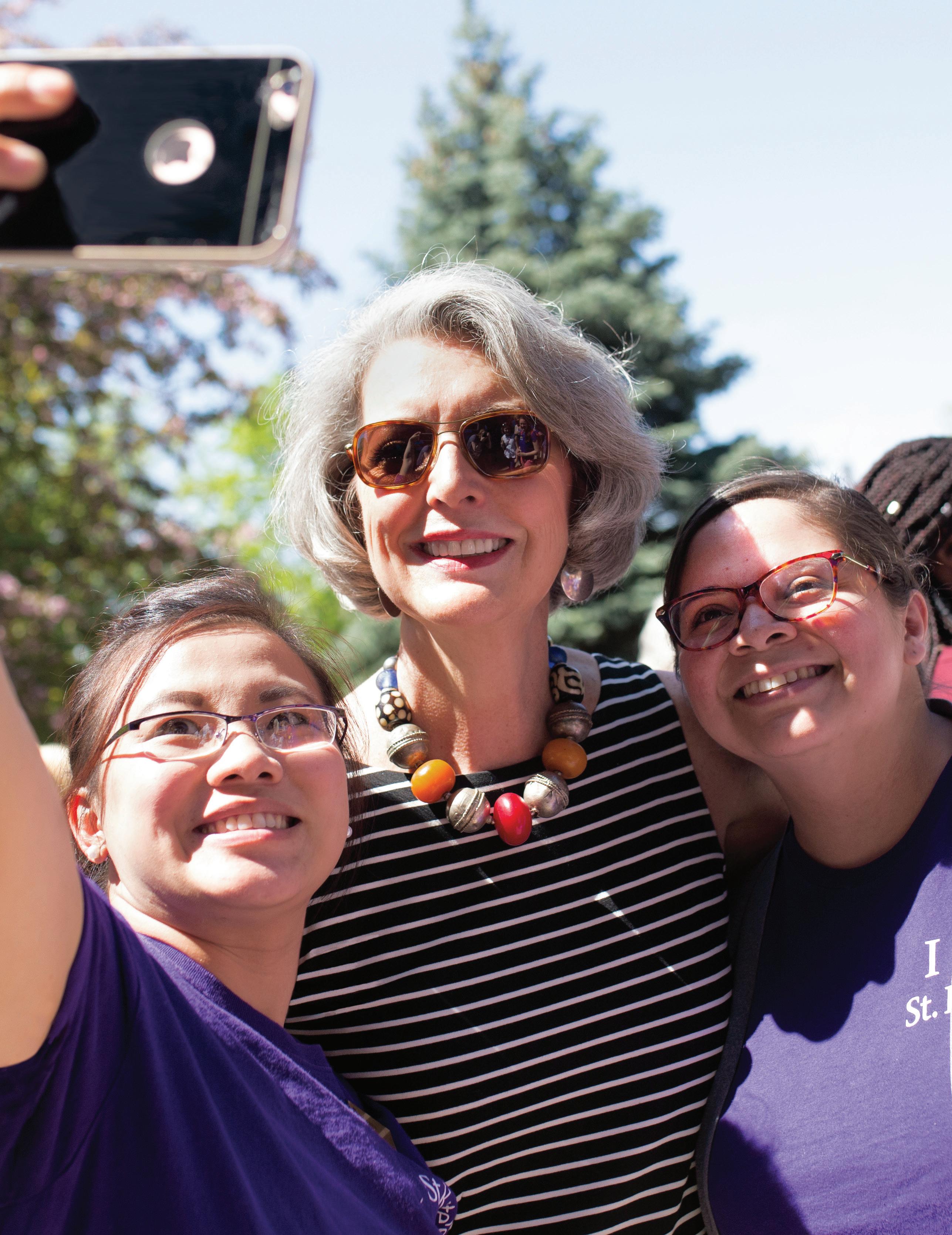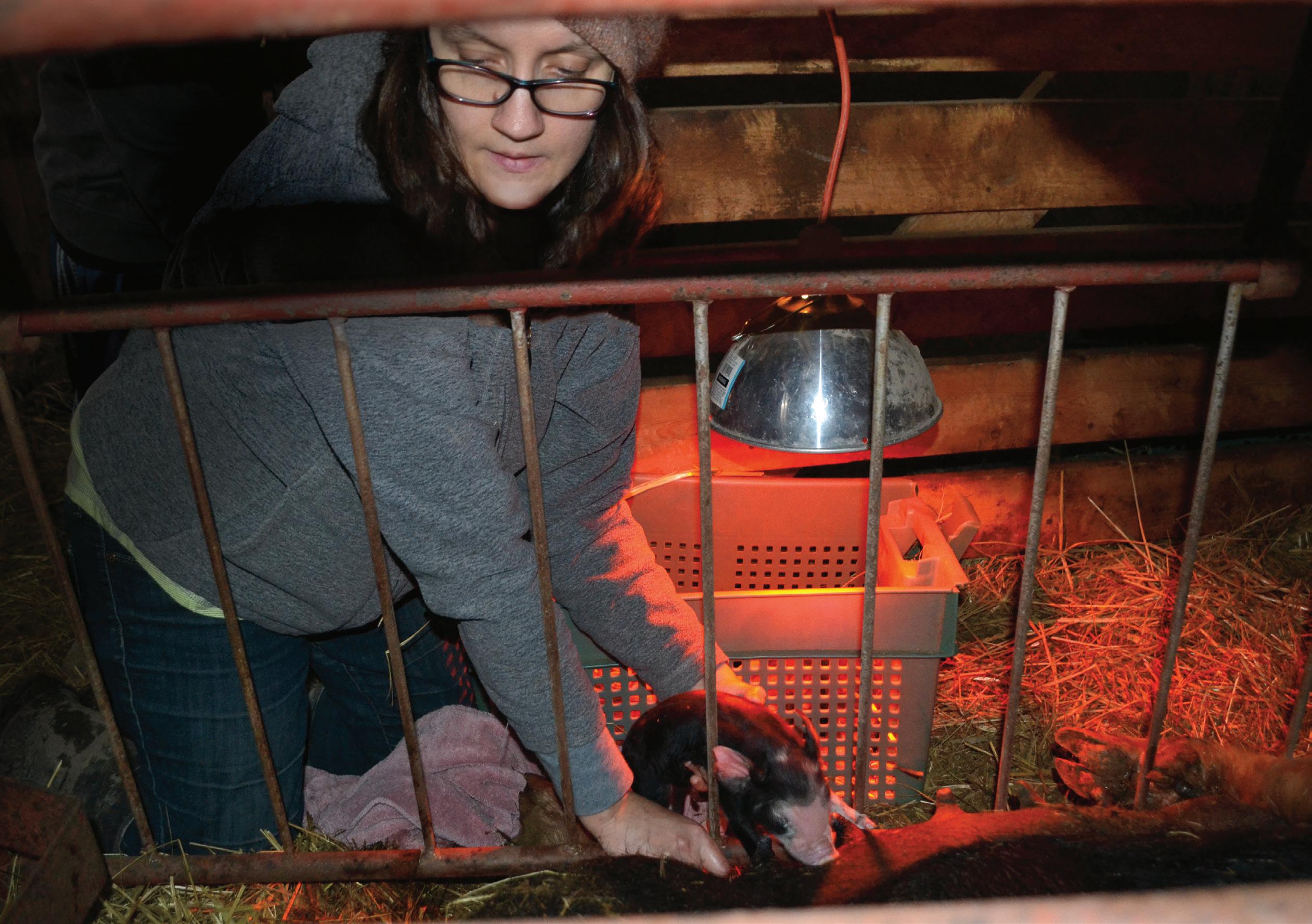
13 minute read
MY ST. KATE’S
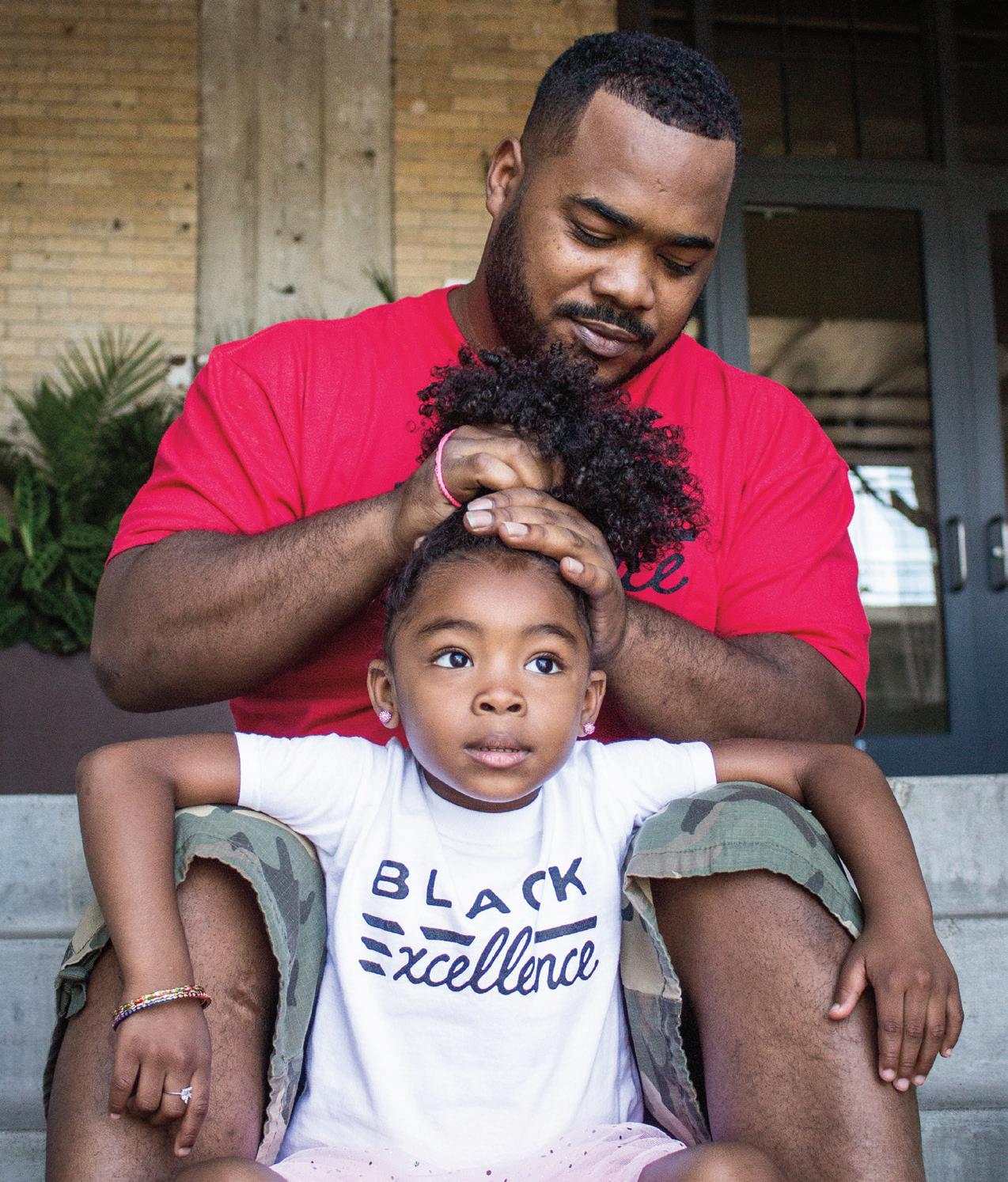
ST. KATE’S STUDENT WITH A NORTH SIDE MISSION BY KATIE MOLNAU ’17
It’s a troubling era for race relations in the United States, and Rebecca Rabb ’16 is bent on easing the tensions with her camera lens. The St. Kate’s business administration major, mother of five and wife is attempting to stop the adverse effects on citizens of color, particularly her neighbors in North Minneapolis, with positive pictures of men and their children.
Rabb first picked up a camera back in high school, but her interest really sparked when she took a photography class at the University last fall. She focused on black barbershops in the North Side for her final project. “There is a rich history in them,” she says, “and I started to see the relationships between the fathers and the sons.”
She began photographing the families, capturing their haircuts and close kinship. Then in November 2015, an unarmed black man named Jamar Clark was killed in a police shooting in her neighborhood. “The images coming out from the media were not an accurate reflection of the solidarity and community that exists on the North Side,” Rabb says. That made her more determined to share her perspective of her beloved community.
She met fathers who knew other fathers, “and they got in touch with other men who were very interested in the project,” she says. Soon, her work grew into a series that honors fatherhood. Within each photo is a smiling man with his equally happy daughter, son or children.
Although her class is long over, Rabb’s dedication to her cause continues. She wants to create a coffee-table book in which each person shares “what being a father means to him,” she explains. The proceeds will go back to the community she calls home.
Katherine “Katie” Molnau is a senior majoring in communication studies.
ALUMNAE COUNCIL PARTNERS WITH STUDENTS, CELEBRATES FIRST FIVE YEARS BY HELEN WAGNER ’69
“Many wonderful things can be accomplished for St. Kate’s students when the University gives caring women the opportunity to do so,” said a member of the St. Catherine University Alumnae Council. And the University did!
In 2011, alumnae leaders created the Alumnae Council, a group of 160 dedicated St. Kate’s graduates committed to raising alumnae engagement with their alma mater to new heights.
Council members determined that the best way to do this was to focus on current students. They launched a wave of academic support and mentoring programs — offering everything from career advice to public speaking tips — and, by 2016, over 2,600 students benefited from the initiative. “I’m grateful for the council’s ongoing commitment to engage in meaningful ways with us,” says one participant, who found the confidence she needed to present at a national undergraduate research conference.
Alumnae engagement also exceeded expectations. By 2014, the number of council members increased by 30 percent, and by last year, more than 85 percent of the members committed to another term.
Council committees are high energy and produce strong results. Each reflects the varied goals and values of St. Kate’s. The Student Hospitality Committee, for example, welcomes nearly 350 first-year students each fall and helps them move into their residence halls; the Young Alumnae Committee offers “Katie Smarts,” expert-led sessions on finance, careers and housing; and the Volunteer Services Committee enables students and alumnae to join forces in “Citizen Katie.” As part of “The Reflective Woman” course, students interview alums for the “Composing a Life” project.
According to one member, “the council shows our re-commitment to St. Kate’s and appreciation for the University.” Another notes that “we have a real sense of responsibility to continue the success of a St. Catherine education for women.”
To learn more, visit: stkate.edu/alumnaecouncil

Pasta, Salad and Pie, Oh My!
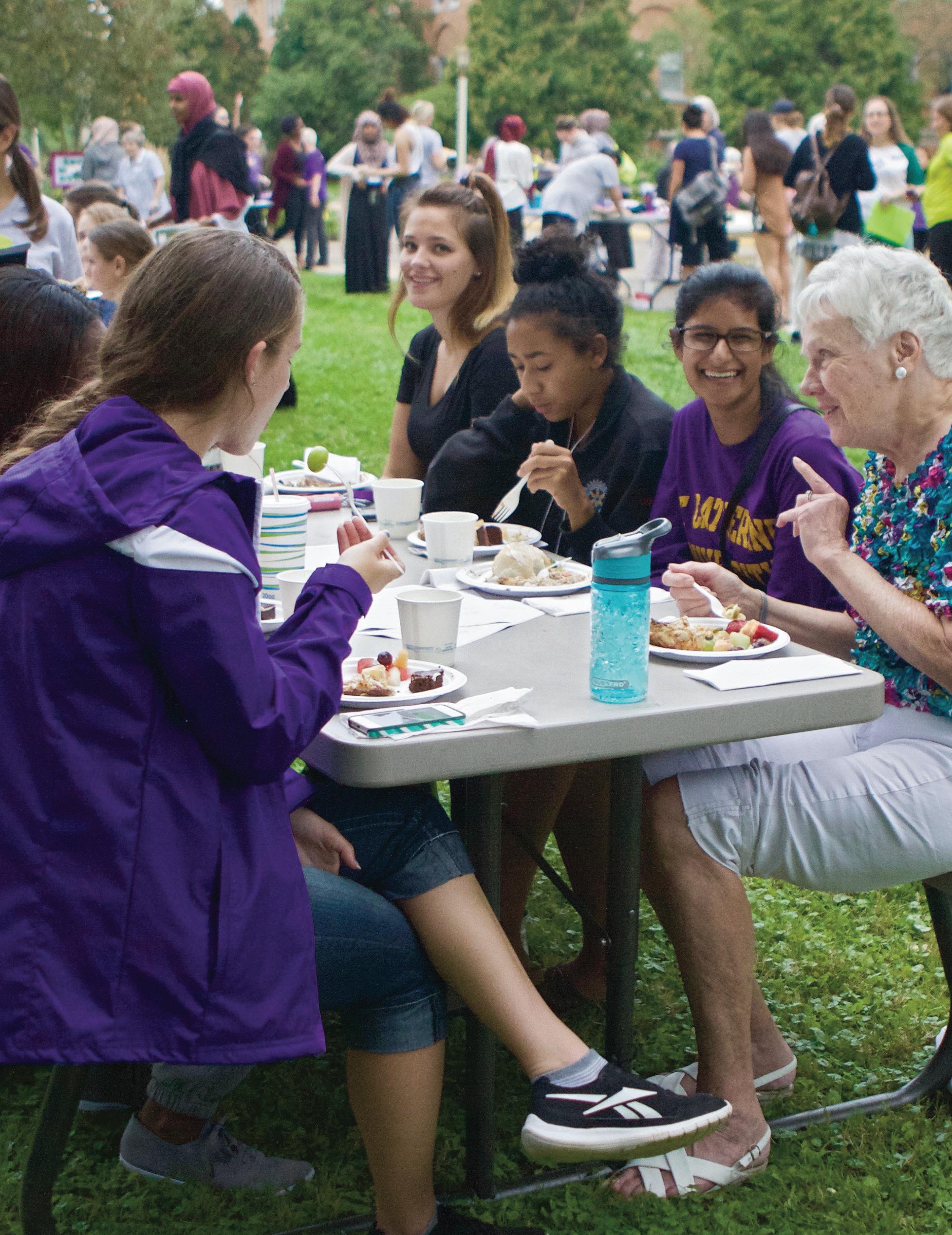
Faculty experts share insights on why we eat and how to eat smarter.
BY SHARON ROLENC
The holiday season is almost here! For many of us, facing an abundance of food and chaotic family gatherings can be stressful, which may affect the way we approach the dining table. Understanding how we eat can go a long way in creating a satisfying holiday meal experience — and maybe even eliminate the need for New Year’s resolutions.
“Each day we make 200 to 250 food-related decisions; some we’re aware of, some we aren’t,” says Mark Blegen, associate dean of the Henrietta Schmoll School of Health and chair of the Department of Nutrition and Exercise Sciences. “Often we ask ourselves, ‘Why am I eating this?’ and the answer is usually ‘because it’s there.’”
Environment, psychology and genetics all play a role in determining how and why an individual eats. And much of this, as Blegen confirms, happens entirely unbeknownst to us. Take the number of people you’re with. You will consume more food when you’re eating with one to seven people. After that, your intake plateaus.
“Seven people is where it seems to level off,” he says. “Eating with familiar people can extend eating time, and you can pick up cues from others, like, ‘they’re eating more so I will too.’”
As a society, we are eating more. Over the past 40 years, the traditional three meals a day around the table has given way to a culture of snacking and convenience. Food access is definitely a culprit in how food is consumed, says Holly Willis, director of nutrition and dietetics at St. Kate’s.
“We’ve accepted that it’s okay to buy food at the gas station or eat during a work meeting, or even while walking down the street. So this [culture shift] has definitely influenced how we eat, why we eat and when we eat,” she says.
Hunger sometimes has little to do with why we eat.
“We live in a culture where hunger is viewed as bad — that people should be comfortable, and have whatever food is needed to be comfortable,” says Willis. She adds, “Food also has become a tool for handling emotions, whether it’s eating more because of stress or not eating at all because of stress.”
These cultural norms, combined with a rise in convenience food and other external factors, can be a recipe for overeating. Luckily, Blegen and Willis offer easy tips to manage these factors during the holidays — and all year long!
If you are preparing the meal, make a list before shopping — and stick to it.
Grocery store environments play into the psychology of eating in numerous ways, from the variety of items offered to attractive snack displays on aisle end-caps, and from lighting to the music playing overhead.
“The slower the beat, the slower you walk. The slower you walk, the more food you see; and the more food you see, the more food you buy,” says Blegen. And it’s no coincidence that staples like eggs and milk are often placed in the back of the store, he adds. “You have to walk by aisles and aisles of other goodies first.”
Use smaller plates and utensils, including serving utensils and glasses.
This is the easiest way to trick your brain into portion control. “There’s a tendency to want to fill up that plate and psychology behind wanting that glass full. So if we have smaller plates and cups and utensils, we tend to eat less,” says Blegen.
Think “nourishing” rather than “healthy.”
“I think people tend to get hung up on the word ‘healthy’ and get sucked into a cycle of bad versus good, which plays into a reward system,” explains Willis. “Grandma’s pumpkin pie can certainly be nourishing, when eaten in the right proportions.”
She suggests focusing instead on balance and moderation. Which leads to the next point…
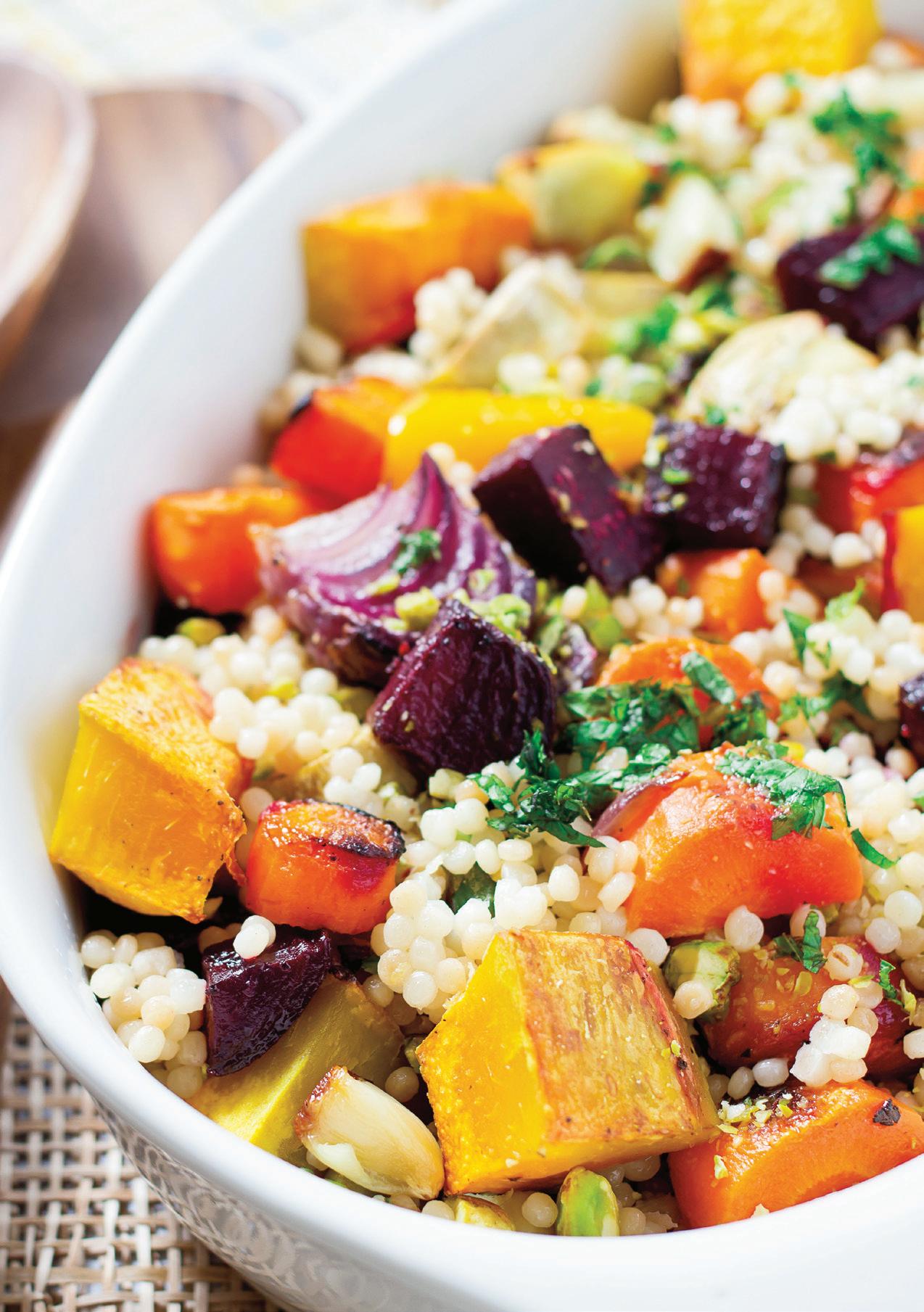
Build your plate with nutrient-rich vegetables and fruits first.
“No matter what your unique dietary circumstances are, veggies and fruit are always a great, nourishing choice,” says Willis. Fill out your plate with smaller portions of other items, like Dad’s juicy turkey or Grandma’s famous pumpkin pie!
Keep food away from the table; put pitchers of water there instead.
“Serve buffet style with the food in a different room, or put the serving dishes away once they’ve gone around the table,” says Blegen. Otherwise, there’s a tendency to graze without thinking. Want to drink more water with your meals? Put a pitcher of it on the table.
In food environment terminology, this is called “reducing the friction.” “Increase the friction to what you don’t want to eat, and decrease the friction to what you do want to consume,” he explains.
Be aware of the “pace car.”
“Most families have a pace car — someone who eats pretty quickly. If you sit next to that person, you tend to pick up your pace,” says Blegen. How fast we eat can impact how much we eat. So think slow and steady. Give your brain and stomach a chance to connect and catch up.
Take time to reflect and give thanks for the food itself.
Pausing for reflection can influence mindfulness and therefore impact the amount eaten.
“Recognize the sacredness of eating and give thanks. This food went through so many hands to get to your table: the farmers who grew and harvested it, the workers in the production facilities and grocery stores, the family members who prepared it,” says Willis.
So take a deep breath, celebrate time with loved ones, give thanks for life’s blessings and dig in!
Want to know if additional exercise allows you to eat that second slice of pie? Read stkate.edu/food
À la Carte! Meals for mind, spirit and mission
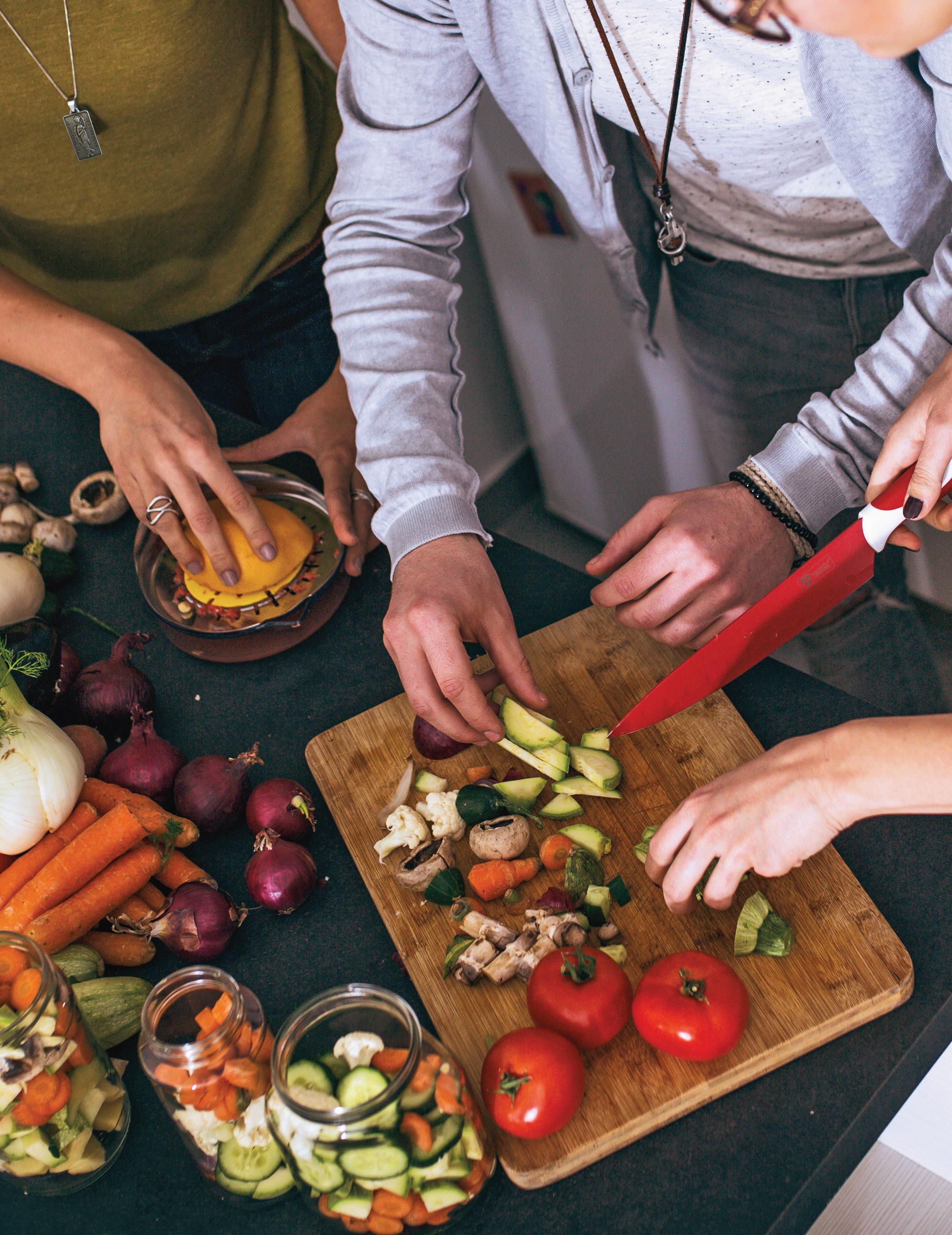
BY ERIN ROSE HENNESSY ’07
What is the last thing you ate? Ask that question on most college campuses and the answers you’ll most likely hear are “a candy bar,” “a slice of pizza” or “a bag of chips.” Convenience foods are staples in a student’s diet as they rush from class to lab to activities, and finally, to tackle that giant load of homework. But at St. Kate’s, you’ll receive a deeper, more thoughtful answer.
Students are inspired to make mindful nourishment a priority. In addition to the University’s dining room and Pulse café, they seek out wholesome meals — and good old-fashioned face-to-face conversation — with these three organizations:
MIPS CORNBREAD AND CHILI
Each month, the Multicultural and International Programs and Services (MIPS) office host cornbread and chili nights. Students plan and facilitate these meals as a safe and positive opportunity to not only build community, but to tackle tough, often controversial topics that affect their lives. Last spring, “Feast or Famine: Does Hunger = Obesity?” addressed the link between food insecurity and physical health. In February, students discussed “It’s Not Skin Deep: Rising Above Colorism” and its effect on women around the world. Other subjects include activism, mental health and breaking the silence.
“I always wonder if students will come, because some of these topics are not easy or comfortable,” says Kimberly Muñoz, MIPS outreach coordinator. “It never fails to surprise me when they do show up. Students yearn to have these conversations, to have an opportunity to come together, ask questions and raise awareness.”
Just ask Alice Fasnacht ’13, a regular visitor during her years as a student. “I found myself in conversations about topics I didn’t know existed,” she recalls. “And that was great. That’s part of what the college experience should be.”
Why chili and cornbread? Why not fish and chips? Well, according to Muñoz, they are both “practical and a source of comfort.” Easy to make and serve, chili is also a staple of a Minnesota diet. (Think hot dish or casserole, without the baking.) That familiarity, Muñoz says, makes chili and cornbread ideal for creating a welcoming environment and nourishing a sense of a second family.
“Food in general brings people together, builds relationships and strengthens community,” she adds. EMMAUS DINNERS AND SOULFUL SHAKES
Chicken Soup for the Soul had the right idea. The spirit needs fuel, too! Students at St. Kate’s can nurture their spirit with Campus Ministry through evenings of community cooking and mid-day milkshakes.
Its Emmaus Dinners are modeled after the scripture reading “Road to Emmaus” (Luke 24:13-35), in which the apostles don’t recognize Jesus until they share a meal together. At these monthly dinners in the Rauenhorst Hall seminar room, everyone is welcome. The only requirements: wash your hands and get ready to cook!
For Our Lady of Guadalupe Night, it’s a Mexican taco fiesta. For Passover, enjoy traditional Jewish foods such as matzo. Once the meal is prepared, conversation continues to flow. Discussion topics often touch on the evening’s theme, and also include select Bible passages and current events. No food goes to waste. Participants leave with leftovers, if there are any delicious morsels left.
“We are feeding the spirit and finding purpose in life, and making sense of the complexities in the world and the values students hold,” says Laurie Svatek, Campus Ministry director.
If you aren’t up for a full meal, how about a shake? In “Shake It Up,” guests gather for milkshakes and dialogue with three to four panelists, including nuns from the Sisters of St. Joseph of Carondelet (CSJ). Monthly topics are typically contemporary and focus on everyday matters, such as the Catholic Church, immigration and the environment.
“The goal is to challenge preconceived ideas and encourage students to think differently about topics,” Svatek notes.
CELESTE’S GARDEN
In Celeste’s Dream Community Garden, a sense of belonging blossoms as students, staff, faculty, Sisters and neighbors gather to grow healthy produce and share bountiful harvests. Currently in its 11th growing season, the two 400-square-foot plots bordering the University’s St. Paul campus are a partnership between the CSJs and St. Kate’s Food Justice Coalition.
“This is a way we can come together to learn skills, engage in community and contribute to the common good,” says head gardener Jennifer Tacheny.
BELOW: AN EVENING HARVEST AT THE CSJS’ GARDEN YIELDS 52 POUNDS OF TOMATOES AND 5 POUNDS OF BEANS. BOTTOM: THIS FALL, STUDENTS ARE GROWING HERBS AND BEE-FRIENDLY FLOWERS ON CAMPUS. (HELP: THE HANDMADE BANNER FOR OUR COMMUNITY GARDEN IS MISSING. EMAIL mag@stkate.edu IF YOU KNOW ITS WHEREABOUTS!)
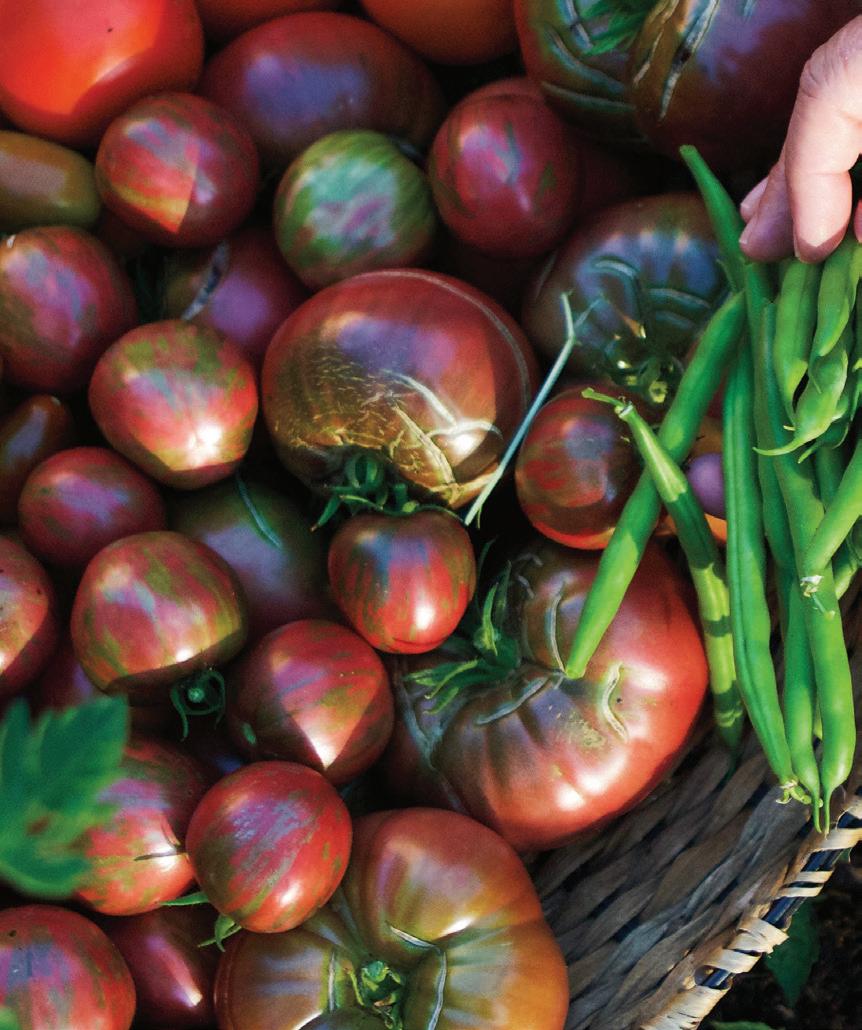
PHOTOS/RYAN JOHNSON ’19
Fasnacht, the MIPS cornbread and chili fan, didn’t need much convincing. “The mission is wonderful,” she offers. “I joined [this horticulture crew] because I love nature, gardening and access to [whole, organic foods].” During harvest season, volunteers get to pick some produce for themselves. The lion’s share goes to Sarah’s… an Oasis for Women, a CSJ ministry that offers transitional housing for women survivors of violence, abuse, war and trauma.
“Healthful food is a continuous part of their growth toward self-empowerment,” says Cathy Steffens ’67, CSJ. “The community garden helps them with that and reduces the need to buy fresh food when it’s available in season.”
To encourage greater student participation, Tacheny collaborates with St. Kate’s Center for Community Work and Learning and faculty who teach “The Reflective Woman,” “Environmental Ethics” and “Rhetoric, Civic Participation and Social Justice” classes.
“The garden is an opportunity for students to lead, influence and tackle both food insecurity and food systems education,” she says. “It is a living symbol of our commitment to Catholic Social Teaching — care for creation or Laudato si’ — and the values of our founders.
This fall, Food Justice Coalition and BioClub members are tending to a new garden outside St. Kate’s dining room. The raised bed is a test plot with vegetables, herbs and bee-friendly flowers. If the plants thrive, the students will install more beds.
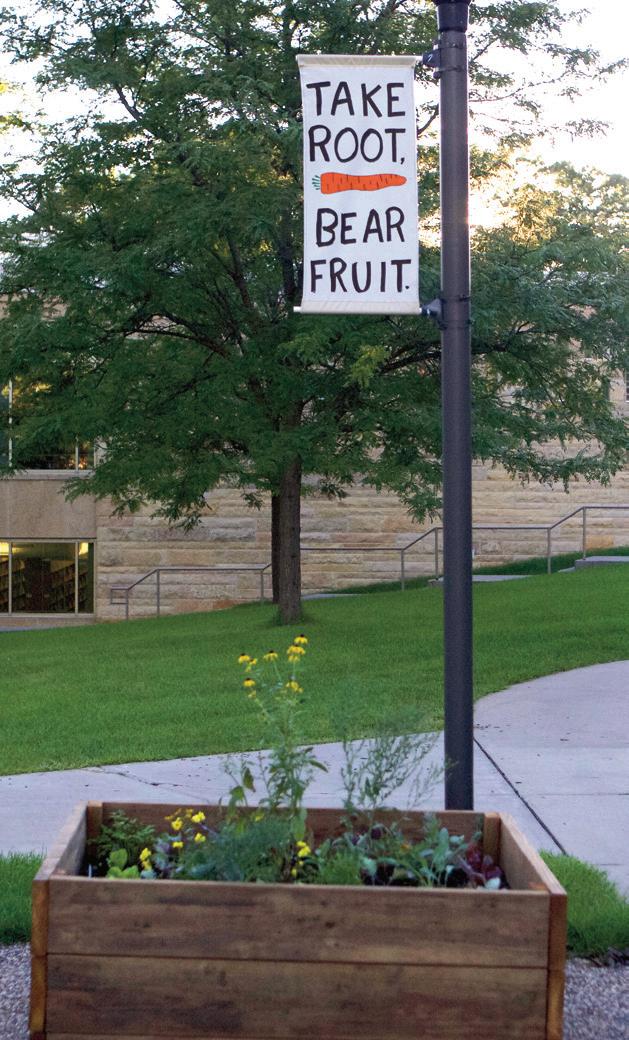
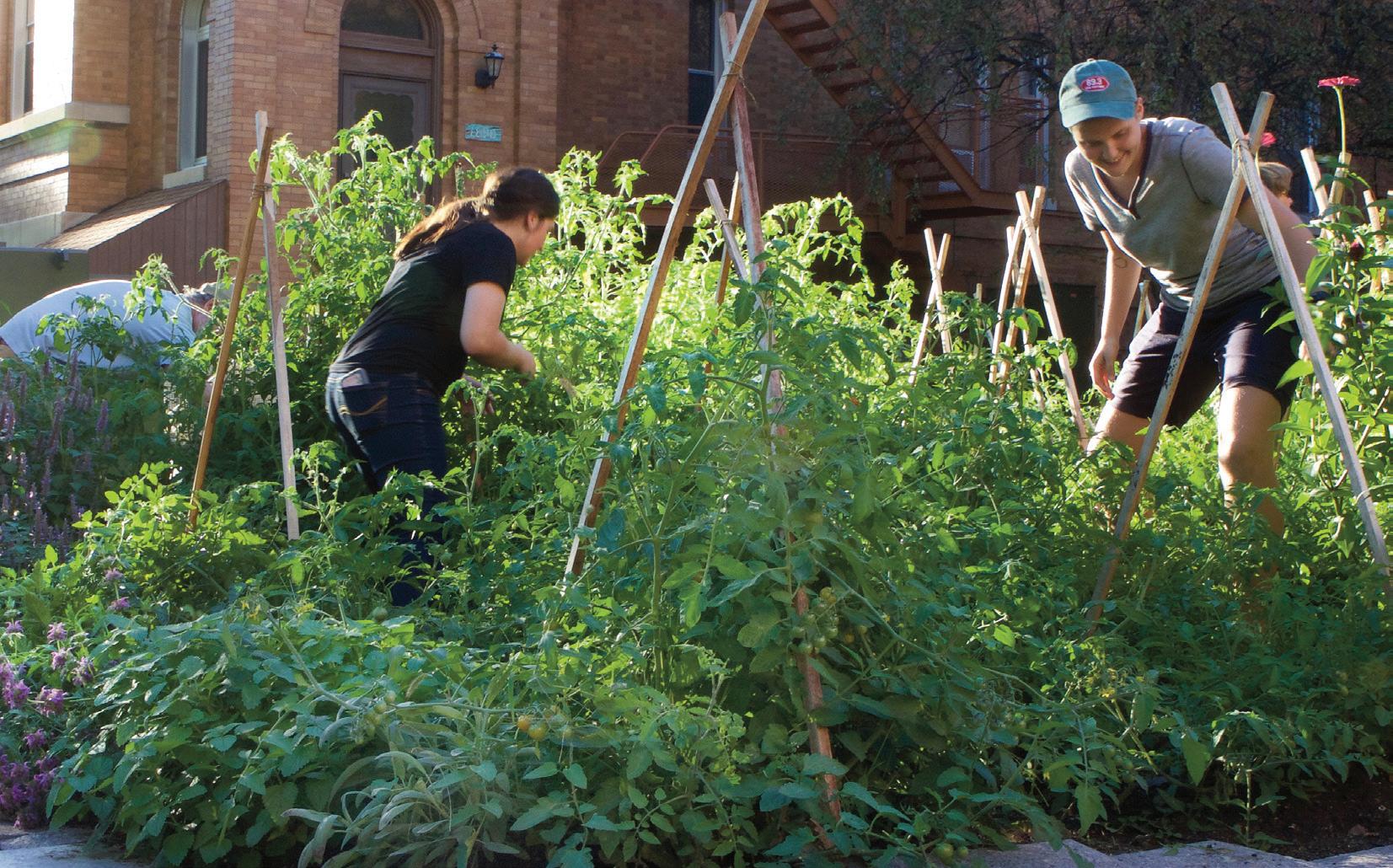
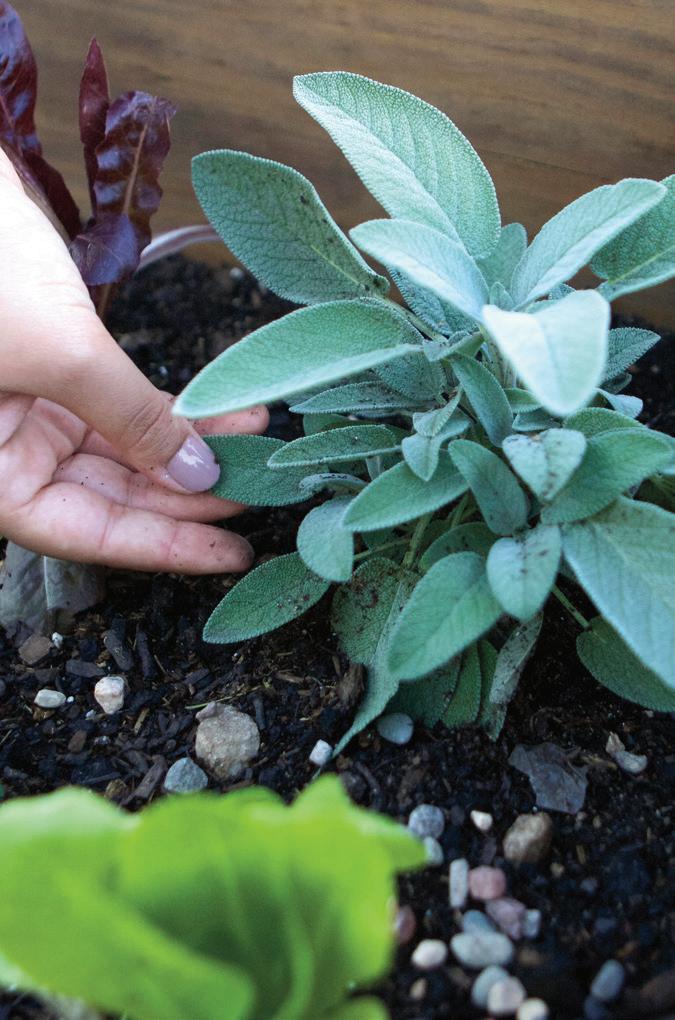
“Gardening is one of the great community builders in history. People bonded over their gardens,” says Esther Swanson ’18. “It’s an ancient art form, and I’m glad we’re going back to it. Gardening is a good life skill to have. We really need to know how to cook more than macaroni and cheese.”





